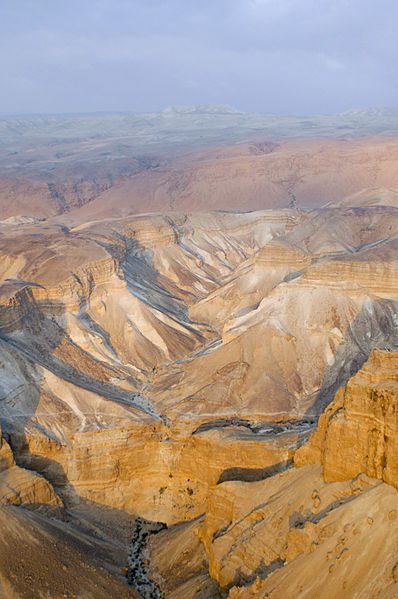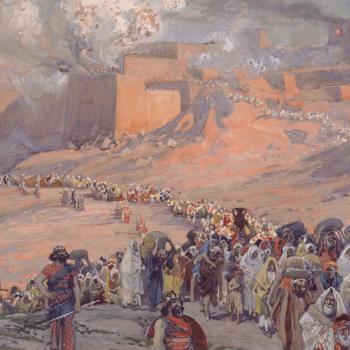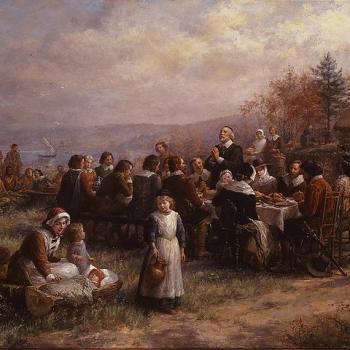
(Wikimedia Commons public domain photo)
For all the talk of a land “flowing with milk and honey,” Palestine is a relatively difficult place to eke out a living. Tahiti might have been nice, with fruit just waiting to be picked. Switzerland is far prettier. Even in the Near East, there are places where it would have been much easier to live a peaceful life. Take Egypt, for instance. With a regular and predictable river running gently through it, separated from would-be enemies by harsh deserts but itself enjoying the lushness of the Nile Valley, Egypt, by the standards of the ancient Near East, was a wonderful place. Palestine, on the other hand, was the highway that nearly every Near Eastern conqueror took to get to his next trophy. President Gordon B. Hinckley once called it, quite accurately, “the bloody doormat of the eastern world.”[1] Why did God put his people there? I think that it may be connected with the development of character. The German poet Goethe noted that, while talent is developed in stillness and quiet, character is developed in the stream, or torrent, of everyday events.* Today the Lord asks us to be in the world, while not of it—to be actively involved in making a living, in raising a family, in marriage—and doesn’t allow us the sometimes tempting alternative of withdrawal to a nice, quiet monastery. So did the Lord plant his people in Palestine, rather than in some more peaceful and pleasant land. We humans seem to need some discomfort to prod us to great achievements; dissatisfaction motivates us to do and to think, to pray and to strive.
God’s concern with the literal soil of Palestine was also reflected in his attention to the way the people behaved on it and in regard to it. It strengthened the passion of the Israelite prophets for proper behavior, for righteousness. Judaism was to be a religion interested in this life, not just in the next. Unlike Buddhism and Hinduism, which encourage us to escape the attachments of earth and mortality, Judaism teaches that this world is—or, at least, can be—sanctified. “And God saw every thing that he had made, and, behold, it was very good.”[2] Righteousness could dwell upon this earth; a sanctified society could be built here. It would be a literal place, with physical structures of brick and stone, not merely a spiritual abstraction.[3] Someday, the Messiah would purify Israel and glorify Jerusalem. The prophets sought, not escape, but the blessing of the Lord upon them and their people in this world as well as in the next. Far from seeking a timeless Nirvana, the Hebrew scriptures pronounced time to be holy. “And God blessed the seventh day, and sanctified it.”[4] Their very positive attitude toward the world, and toward time, almost guaranteed that the Hebrews would take history seriously. God, they were convinced, revealed himself in this world and acted in this earthly time. And it was their religious duty to record those revelations and mighty acts. As Paul Johnson points out, the Jews
were the first to create consequential, substantial and interpretative history . . . [T]hey were fascinated by their past from very early times. They knew they were a special people who had not simply evolved from an unrecorded past but had been brought into existence, for certain definite purposes, by a specific series of divine acts. They saw it as their collective business to determine, record, comment and reflect upon these acts. No other people has ever shown, particularly at that remote time, so strong a compulsion to explore their origins. The Bible gives constant examples of the probing historical spirit: why, for instance, was there a heap of stones before the city gate at Ai? What was the meaning of the twelve stones at Gilgal? This passion for aetiology, the quest for explanations, broadened into a more general habit of seeing the present and future in terms of the past. The Jews wanted to know about themselves and their destiny. They wanted to know about God and his intentions and wishes. Since God, in their theology, was the sole cause of all events—as Amos put it, ‘Does evil befall a city unless Yahweh wills it?’—and thus the author of history, and since they were the chosen actors in his vast dramas, the record and study of historical events were the keys to the understanding of both God and man. Hence the Jews were above all historians, and the Bible is essentially a historical work from start to finish.[5]
The people of Israel were not great craftsmen, or painters, or architects. But writing was their national habit, almost their obsession. They probably produced, in sheer quantity, the greatest literature of antiquity, of which the Old Testament is only a small fragment. . . . [They] saw literature as a didactic activity, with a collective purpose. It was not an act of personal self-indulgence.[6]
* Es bildet ein Talent sich in der Stille, Sich ein Charakter in dem Strom der Welt. (Goethe, Torquato Tasso, I.ii.66)
1] Cited by Truman G. Madsen, in his foreword to Baldridge, Grafting In, i.
[2] Genesis 1:31. It is beyond the scope of this book, but I would like to suggest, even if I cannot develop the thought here, that Latter-day Saints share this positive evaluation of the world. We do not dream of “escaping the body,” and we are not inclined to asceticism. There are no Latter-day Saint monks. See Daniel C. Peterson and Huston Smith, “Purpose of Earth Life: Comparative Perspective” in Daniel H. Ludlow, ed., Encyclopedia of Mormonism (New York: Macmillan, 1992), 3:1181-83.
[3] Latter-day Saints, too, have their attachment to a land. There is Utah, “sacred home of the prophets of God” in the words of the hymn. Even more, there is the New Jerusalem, someday literally to be built of actual brick, steel, glass, boards, and stone. It is not a mere spiritual abstraction. And if Zion means “the pure in heart,” as it does (Doctrine and Covenants 97:21), it also signifies a literal place. Interestingly, some nineteenth- century critics of the Church thought it too concerned with fields and barns and fences to be truly “spiritual.” Nowadays, one occasionally hears the criticism from liberal Protestant and Catholic theologians and from secularizing critics that the doctrines of the Restoration are too concerned with the next life; such critics, having often themselves abandoned their belief in transcendent matters such as life after death, now focus on religion as a tool for social reform. Amidst the fashions of the world, however, the Church goes on its way. It sanctifies the world of work and everyday life, teaching that cleaning one’s yard or digging irrigation canals in pioneer Deseret can be an act of worship, while at the same time it regards the life to come as a literal reality. Like their predecessors, modern prophets teach a balance between this life and the next. The two are, after all, not so very different.
[4] Genesis 2:3.
[5] P. Johnson, History of the Jews, 91-92.
[6] P. Johnson, History of the Jews, 88.












